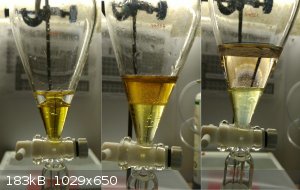beta4
Hazard to Self
 
Posts: 56
Registered: 3-2-2019
Member Is Offline
|
|
Preparation of chlorobenzene from sodium dichloroisocyanurate (NaDCC)
This synthesis is based on a previous sciencemadness thread which discussed a preparation of chlorobenzene from benzene and TCCA [1]. Using NaDCC
instead of TCCA has been discussed before, but no experimental results have been reported [2].
The reaction was performed at 85mmol scale and produced chlorobenzene in 31% yield.
Experimental
The benzene used was synthesized from benzoic acid and sodium hydroxide. NaDCC was acquired OTC as pool chlorine, the label lists no other ingredients
than NaDCC, but is likely technical grade.
The apparatus used consists of a two neck flask with a pressure equalizing addition funnel and a vertical condenser set up for reflux. At the top of
the condenser a gas adapter is used to connect the outlet through a tube to a suckback trap and a chlorine scrubber filled with ~6g NaOH and 400mL of
tap water. The chlorine scrubber was probably unnecessary, as the reaction did not generate large amounts of chlorine, only slight bubbling during the
initial heating.

The reaction flask was loaded with 10.6g of NaDCC and 7.5mL of benzene. The addition funnel was attached to the reaction flask and filled with 5mL of
deionized water and 7.5mL of ~95% sulfuric acid. Stirring is started and the dilute sulfuric acid is added dropwise. The use of an addition funnel was
selected because I expected some immediate chlorine evolution, however none was observed.
The flask was heated without using a water or oil bath. The hotplate was set to 80°C initially, but later raised to 130°C. The content of the flask
became milky white with some bubbling observed. Heating was continued for a total of 7 hours, during which no visible reflux was oberved in the
condenser.
After letting the apparatus cool, the addition funnel was removed and the condenser was rearranged for distillation.
Distillation was possible without an oil bath at reasonable hotplate temperatures (350°C). The distillate came over between 80 and 90°C, at a
temperature significantly lower than the chlorobenzene boiling point. The distillate phase separated in a dense yellow organic layer at the bottom,
and a clear water layer at the top.
The residue in the reaction flask cleaned easily by soaking overnight in tap water, and was discarded in a benzene waste container.
A separatory funnel was used to process the yellow organic layer, which was put back in the funnel and washed with 1M NaOH solution. Most of the
yellow impurities transfered to the aqueous layer, leaving a pale yellow organic layer at the bottom, which was washed again with deionized water. The
result of these washing steps was 6mL of a yellowish-white organic liquid.

From left to right: crude product, NaOH wash, final water wash.
A final distillation was done to purify the product and check its boiling point. A 100mL erlenmeyer flask was used to provide better thermal contact
with the hotplate. During the distillation, the first drops came over at a still head temperature of 80°C, likely unreacted benzene. Due to the very
small scale of the distillation, and the fact that some benzene was collecting in a small puddle before the condenser, the distillation was stopped
when the still head reached 125°C, and after letting everything cool, the condenser was cleaned and the distillation was restarted.
Some charred organic material remained in the erlenmeyer after the distillation, which cleaned with hot concentrated sodium hydroxide solution.
Results
The product distilled between 130 and 140°C, consisting in 2.5mL of clear chlorobenzene weighing 3.00g. Density is thus 1.2g/mL, and the yield on
benzene is 31%.

Discussion
The yield of 31% is lower than the 40% reported for the synthesis form TCCA [1], however this can be attributed at least in part to losses due the
very small scale of the reaction (1/10th the scale of [1]). Especially at the end of the final distillation, reflux of a clear liquid was observed in
the still head, hinting to the presence of more product being lost. Moreover, the initial collection of unreacted benzene suggests that an increase of
the reflux time beyond 7 hours may further increase yield.
The slightly higher density and boiling point (nominal chlorobenzene density is 1.11g/mL and boiling point 131°C) may suggest some dichlorobenzenes
contamination.
A video of the reaction is also available: https://youtu.be/IMFWT_2pWLw
References
[1] https://www.sciencemadness.org/whisper/viewthread.php?tid=80...
[2] https://www.sciencemadness.org/whisper/viewthread.php?tid=64...
|
|
|
Fery
National Hazard
   
Posts: 990
Registered: 27-8-2019
Location: Czechoslovakia
Member Is Offline
|
|
beta4 very nice, thank you for sharing
according the yield, did someone try the chlorination by Cl2 gas and anhydrous FeCl3 (Fe dust into the benzene which initially reacts with Cl2 into
FeCl3) - the yield should be approx twice better ?
|
|
|
beta4
Hazard to Self
 
Posts: 56
Registered: 3-2-2019
Member Is Offline
|
|
The reaction was chosen mostly based on what reagents I already had available and ease of synthesis rather than yield.
Making Cl2 gas is not too difficult, but still requires to consider how to dry it, and is more hazardous. Also, I don't have Fe powder around.
I may consider trying alternative routes in the future, but now it's cold outside and it's no longer comfortable to keep the garage door open. Which
reminds me I have to finish building my fumehood.
|
|
|
UC235
National Hazard
   
Posts: 565
Registered: 28-12-2014
Member Is Offline
Mood: No Mood
|
|
No need for iron powder. Some extra fine steel wool degreased with hexane or acetone beforehand makes a fine in-situ FeCl3 catalyst and can be
obtained at any hardware store. I used the same strategy for bromobenzene. The only downside is that it doesn't break down and made stirring a bit
difficult. You could probably cut it up easily beforehand with scissors to fix this though.
[Edited on 16-10-2020 by UC235]
|
|
|
Fery
National Hazard
   
Posts: 990
Registered: 27-8-2019
Location: Czechoslovakia
Member Is Offline
|
|
Hi UC235, no worry, I have approx 1 kg of pulverized Fe reduced by H2 (so very pure) and similar amount of Fe produced by pentacarbonyl method (which
is even much purer than the previous one). I'll have also anhydrous FeCl3 (righ now on the way, ordered recently). I was just curious whether the
yield of benzene+Cl2+FeCl3 reported in literature is really twice better than NaDCCA method. Anyway the NaDCC method posted by beta4 is much safer
than working with Cl2 gas and if you do not need too much chlorobenzene it is the most convenient method in home lab.
|
|
|